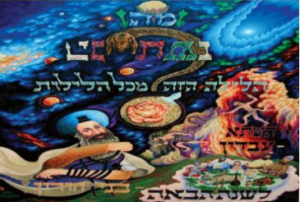Parshat Bo 2022
By Rabbi Moshe Goodman, Kollel Ohr Shlomo, Hebron
בס”ד
לשכנו תדרשו
Discover the Holy Presence in Our Holy Land
The Exodus

This painting exhibits many themes of the Exodus apparent in parshat Bo, and Pesach the Holiday of the Exodus. The words Mah Nishtana and “Hashata Avdin etc.” all said on Seder Night are obvious references to this matter. Notice how the verb root letters for change “shin, nun, and heh” in “Nishtana” are all altered and changed in their form and direction of writing in order to reflect the theme of alteration and unusual changes made on Seder Night so that children will ask questions, and the parents will accordingly tell them the story of the Exodus.
While the man putting on tefillin and the family celebrating Seder Night, the Paschal lamb in the middle of “Nishtana” and the Egyptian whipping the Jew are all obvious inferences to the Exodus story, there are other motifs in this painting that are less obvious. On the round matza in the center of the painting is a rose and a dove. The rose seems to allude to the People of Israel likened to a rose in Shir Hashirim where the wife, which according to our Sages corresponds to Israel, is called a “rose amongst the thorns,” meaning that Israel, the eternal Nation, persevere despite all their enemies – “thorns” – throughout the ages. The dove also seems to allude to Israel, since our Sages ascertained that “Israel are likened to a dove” (Sanhedrin 95a) in their faithfulness to Hashem, just as a dove is faithful to its mate. It seems that images appear upon the round matza, the symbolic food of the Exodus, to show that with the Exodus also the People of Israel were born as a nation.
To the sides of these Exodus themes in the center, there can be seen a drop/spark descending from above to below to the right, while to the left a fire with smoke ascending from below to above can be seen. It seems that these oppositely directed images to the right and left reflect the idea of the People of Israel, born in the Exodus, uniting Heaven/the Divine and Earth, raising spiritual “sparks” from below to above, and thereby summoning Divine blessing coming from above to below. This matter is of course a major theme of Hebron meaning unity – “hibur” – where Nachshon lived and painted; this is the City of Unity tying Heaven and Earth, Threshold of Ascent towards the Afterlife, the Ancestral Roots of the Jewish People who play the eternal symphony of Heaven and Earth in an everlasting union.